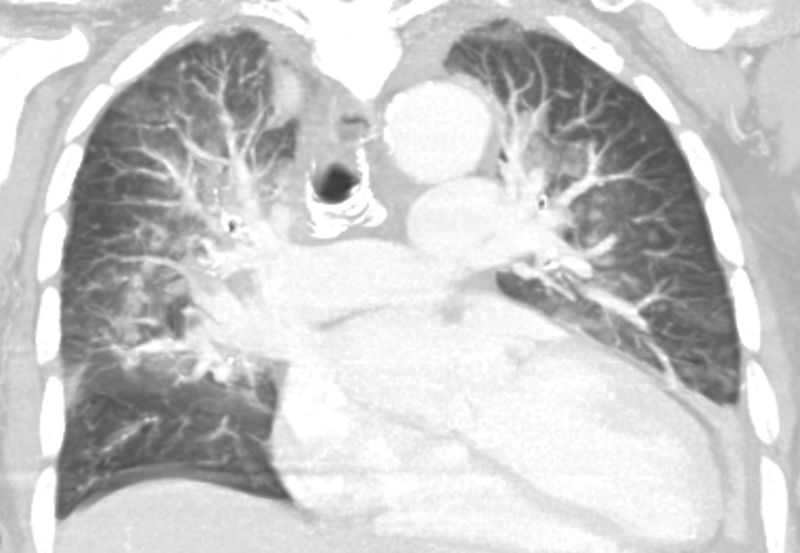Pulmonary Edema
Often our tepid dosing of nitroglycerine is to blame for treatment failure - Rory Spiegel MD

image by: Hellerhoff
HWN Suggests
Shift Away from Loop Diuretics for Pulmonary Edema
Improving upon the classic LMNOP approach (Lasix, morphine, nitrates, oxygen, PPV) to congestive heart failure, innovations in modern cardiogenic pulmonary edema management revolve around a growing understanding of the disparate fluid states that may exist between the systemic and cardiopulmonary circulations, that patients with acute pulmonary edema may still be euvolemic or hypovolemic with long-term diuretic use. This two-buckets theory has prompted a focus on preload reduction rather than diuresis, and care has shifted away from rapid administration of loop diuretics and now prioritizes the use of high-dose nitroglycerin and noninvasive ventilation.
Resources
 High-Dose Nitroglycerin for Sympathetic Crashing Acute Pulmonary Edema
High-Dose Nitroglycerin for Sympathetic Crashing Acute Pulmonary Edema
Nitroglycerin (NTG) is an important intervention to consider for patients with Sympathetic Crashing Acute Pulmonary Edema (SCAPE) as it significantly reduces preload, and even modestly reduces afterload with high doses.
 I Love Me Some High-Dose NTG and NIV for SCAPE
I Love Me Some High-Dose NTG and NIV for SCAPE
Hypertensive acute heart failure is a subgroup of acute congestive heart failure (CHF) patients. Physiologically there is increased afterload and decreased venous capacitance both leading to fluid shifts resulting in pulmonary vascular congestion. Sympathetic crashing acute pulmonary edema (SCAPE) is a severe form of hypertensive acute CHF.
 SCAPE (Sympathetic Crashing Acute Pulmonary Edema)
SCAPE (Sympathetic Crashing Acute Pulmonary Edema)
A SUDDEN onset of acute shortness of breath caused by rapid redistribution of intravascular fluid into the alveolar space. It is NOT FLUID OVERLOAD. SCAPE is a sub-type of acute decompensated cardiac failure- the worst case of acute heart failure syndromes- the one most likely to get our attention as EM Physicians because of its dramatic, life threatening presentation.
Acute Cardiogenic Pulmonary Edema – A complete review of “flash” pulmonary edema
IV nitrates (even high doses up to 2mg) and IV ACE inhibitors are generally supported by current evidence to be both safe and effective, although high-quality evidence is lacking. IV furosemide, if given to the fluid-overloaded patient, should be given AFTER treatment with nitrates and ACE inhibitors to avoid unintended increased vascular tone.
Beyond the Basics: Pulmonary Edema
The most common etiology for pulmonary edema is myocardial infarction. Some of the less common causes of pulmonary edema include infectious cardiac disease processes, such as acute myocarditis or endocarditis; induced heart failure from drugs/medications like cocaine, beta-blockers or tricyclic antidepressants; trauma-related, such as a myocardial contusion; or metabolic derangements that result in cardiac arrhythmias, such as sustained tachycardias or bradycardias.
Bolus Dose Nitrates in Acute Pulmonary Edema
Often our tepid dosing of nitroglycerine is to blame for treatment failure. Multiple studies have demonstrated the advantages of bolus dose nitroglycerine in the early management of patients with acute pulmonary edema. In these cohorts, patients bolused with impressively high doses of IV nitrates every 5 minutes, are intuabted less frequently than patients who received a standard infusion.
Diagnosis of Acute Cardiogenic Pulmonary Edema (ACPE) with Point-of-Care Ultrasound
Lung US is a great tool to diagnose ACPE, with excellent test characteristics.
Doubling Down on Re-Expansion Pulmonary Edema: Treatment Approach and Ventilator Management
How is REPE treated? The mainstay therapy for mild cases is well-described in the literature and consists of supplemental oxygen and cautious diuresis. The mechanism of REPE is different from that of cardiogenic edema
EMS Protocol of the Week - Respiratory Distress / Failure / Acute Pulmonary Edema (Adult)
Prehospital management of the adult in respiratory distress generally boils down to APE or asthma/COPD, with the occasional interesting obstructed airway case.
Flash pulmonary edema
Also known as "sympathetic crashing acute pulmonary edema" (SCAPE). Different from acute CHF exacerbation or hypotensive cardiogenic shock, which do not have sympathetic overdrive
Furosemide in the Treatment of Acute Pulmonary Edema
There’s minimal or no role for the administration of loop diuretics early in the management of APE. The majority of patients aren’t volume overloaded. 2. Immediate care should focus on NIPPV and administration of nitroglycerin.
Sympathetic Crashing Acute Pulmonary Edema (SCAPE)
SCAPE occurs due to a vicious spiral involving increasing sympathetic outflow, excessive afterload, and progressively worsening heart failure. Since SCAPE is a vicious spiral, this may develop very rapidly (hence the terminology “flash pulmonary edema”). With aggressive therapy, it may resolve very rapidly as well. The central, defining pathophysiological feature of SCAPE is pathologically elevated afterload due to systemic vasoconstriction and hypertension. SCAPE patients may be euvolemic or hypovolemic. The problem is a shift of fluid into the lungs, rather than hypervolemia.
 Shift Away from Loop Diuretics for Pulmonary Edema
Shift Away from Loop Diuretics for Pulmonary Edema
Managing cardiogenic pulmonary edema in the emergency department is a complex and critical call of the emergency physician. These patients often arrive in profound distress, requiring immediate bedside response and comprehensive intervention.
Core EM
APE, CHF exacerbation and cardiogenic shock are different diseases and must be approached and treated differently. The lungs in a patient with APE are like an overflowing bathtub. We have to simultaneously stop the inflow of blood by turning off the tap (preload reduction) and increase outflow by unclogging the drain (afterload reduction).

Introducing Stitches!
Your Path to Meaningful Connections in the World of Health and Medicine
Connect, Collaborate, and Engage!
Coming Soon - Stitches, the innovative chat app from the creators of HWN. Join meaningful conversations on health and medical topics. Share text, images, and videos seamlessly. Connect directly within HWN's topic pages and articles.













